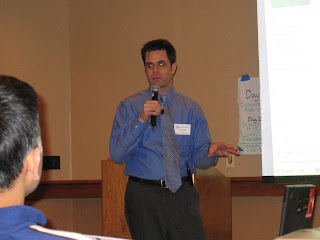 (Pictured here - David, the brains behind Mashup Camp)
(Pictured here - David, the brains behind Mashup Camp)
My day started with a session on the Semantic web. There was much discussion on how this needed to be done in small chunks and that there wasn't much incentive for people to implement the semantic web, so it needs to be incidental to some other value derived from implementing the semantic web. There were discussions on the upper versus lower case semantic web and how we need to get there in small steps. One woman as well discussed concerns over privacy associated with the semantic web cataloging information about people such as skype numbers, cell phone numbers, etc... Her comment was that woman have to worry about being Skype Stalked if their information is too open.
My own comment was that Sematic Web needs to be dumbed down. Its way to complicated for the masses when it uses terms like ontology, semantic, etc... I struggle with the concepts and terms, until it is simpler it wont be universal, and until its universal, it wont hit critical value.
At the end of the talk, there was a side demo done of a new Semantic Web product called BigSwerve (seemed to be a MyBlogLog competitor).
My next session was on Commercialization and Licensing of Mashups. There were alot of concerns about exploding mashups that get shutdown by webservices they rely on. There was alot of concerns and questions on Terms of Services and the ambiguity built into them, for instance what is a commercial site? Google's definition is if you take money to log into a system. However, it is not defined and most people agreed that was likely on purpose. Someone there built the Amazon Light based on the Amazon API but linked to Netflix from the videos and got a cease and desist letter from Amazon. Cease and desist letters seemed more common then I expected. There was talk about using the Mashup Wiki to start a project to define terms of service that developers hope the big API providers adopt. There was some disension that this would be a waste of time.
At lunch my discussions continued with a company that build websites for government and public sector orgs. The attititude was they we know we are violating terms of service, but we really dont have an option. One lady said see wanted to pay a quarter per web service call for her 100 calls a day. She called the end vendor but they didn't offer anything less than $5000 to get anything, so instead she just continued to use the service violating the terms of service. It seems the web services business models don't care about the micropayments. They might learn a lesson from Google that makes a fortune 1 nickel at a time.
Following lunch was Speed Geeking with about 20 mashups. I got a chance to see the following Mashups:
1) GoogleBase(semistructured data) + GoogleGadgets = BaseGadgets from a Google employee.
2) GanstaMap.com
3) RoboCal - Google Calendar + a text-to-speech webservice. Can call you when things on your calendar are due. Also there was a botcastbuddy.com which calls you and reads whats in your bloglines account.
4) iGem - genetic engineering competition wiki looking for ways to break down the silo between teams.
5) StrikeIron - reseller of API data for Mashups making it more affordable. They showed an Excel widget they have to pull lots of data.
6) Proto - development environment for writing mashups are other programs.
7) Yahoo did MyBlogLog mashups combined with delicious bookmarks
8) IbisEye did a mashup for a historical data hurricance tracking system in which you could see the path of a hurricane from 70 years ago.
9) Hype machine - music tracking mashup
10) AOL demo of Boxely and WIM mashed up.
11) BookSearchTimesThree - searching the text inside any book. Takes the 3 sources, Amazon, Google, and someone else(?) and combines the results.
Next I saw a presention from Dapper which was much like Kapow. This seems like a very exciting area - creating an API from HTML where an API does not exist. Their technology seems pretty powerful and everyone in the audience was very excited about it.
The conversation also sequed into a discussion on terms of service, ownership of content, etc... For instance, Facebook data ownership. Facebook has a license to the data. The owner actually owns the data. So if you write a Dap to it, who's permission do you need? An article from AP on the New York Times - how do you get rights to Mash that up?
Comment posted by Techrigy, Inc.
at 1/18/2007 9:08:00 PM
Sorry for the misunderstanding. I wasn't trying to reference an actual article. What I meant was "who has ownership of an article I want to use in my Mashup". If the article is being taken from the NY Times but it is an AP article that NY Times is paying to syndicate? Someone during the discussion brought up this as an example of how difficult it can be to assign ownership of data you are Mashing Up.
Comment posted by searob11
at 1/18/2007 1:03:00 PM
I am looking for but unable to fing the AP/NYT article you refer to in your post.


